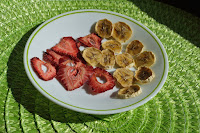I was in a conversation with a friend the other day talking about vitamins, and she said something like, 'Well, if I get too much Vitamin D, I'll just pee it out.' I said, 'No, your body stores it!'
And that, in a nutshell, is the major difference between water-soluble and fat-soluble vitamins. The important piece being that you won't likely have too much of a water-soluble vitamin in your body, but you can accumulate high amounts of fat-soluble vitamins and that may be harmful.
I've shared information from Fat-Soluble Vitamins: A, D, E, and K - 9.315 from Colorado State University The authors are J. Clifford and A. Kozil. Please read the article as it contains quite a bit of excellent information I've not included here like quantity needed and signs of deficiency.
Here is the basic info:
- Small amounts of vitamin A, vitamin D, vitamin E and vitamin K are needed to maintain good health.
- Fat-soluble vitamins will not be lost when the foods that contain them are cooked.
- The body does not need these vitamins every day and stores them in the liver and adipose (fat) tissue when not used.
- Megadoses of vitamins A, D, E or K can be toxic and lead to health problems.
- Requirements for vitamins may be expressed in different mathematical units. Close attention should be paid to ensure that similar units are being compared.
As stated, the vitamins that area stored in your body are A, D, E, and K.
Vitamin A sources are dairy and fish. Also, your body converts beta-carotene to Vitamin A, so carrots, pumpkins, squash, and other orange vegetables, as well as dark green leafy vegetables are good sources.
Vitamin D sources are mainly sunlight - your body makes this vitamin when skin is exposed to sun. [Other sources state about 20 minutes daily of sun exposure without sunblock will suffice to make an adequate amount of this important vitamin.] Food sources can be fortified dairy products, oily fish, and cod liver oil. This source recommends exposure to sunlight without sunblock for 10 to 15 minutes twice a week. Vitamin D is extremely important to a strong immune system.
Vitamin E sources are fruits and vegetables, nuts, grains, and sunflower seeds.
Vitamin K food sources are green, leafy vegetables like spinach, cabbage, cauliflower and broccoli.
Here is another excellent website article containing information on fat-soluble and water-soluble vitamins as well as micronutrients: Vitamins and Minerals Are You Getting What You Need - A Harvard Health Article.





